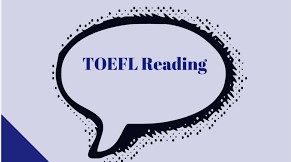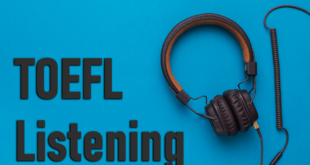
General Tips and Format for TOEFL Reading Section.
The TOEFL iBT is divided into four sections:- Reading, Listening, Speaking, and Writing. You got 54 minutes for three reading passages and 18 minutes per passage, for reading and answering the accompanying questions. There could be 4 passages with an experimental section with 72 minutes for all and 18 minutes per passage. Each passage contains 750 words and 10 MCQs in just 18 minutes.
All reading passages are classified into three: exposition, argumentation and historical. Often, passages present information from reading passage that offers more than one perspective to a topic.
Essentially, there will always be that one question to test your understanding of the organization pattern of the passage which is either classification, compare/contrast, cause/effect, problem/solution. You must read through or read till the end of the passage before receiving questions on that passage.
Once the questions appear, the passage appear on the right side of the computer screen while the question appears on the left. After the full passage, questions are grouped by paragraph, which saves time and makes it easier to find answers to the questions.
The test may allow you to click on unfamiliar words and get a definition. All questions carry equal mark, don’t get stuck for too long on any question. You don’t need to be familiar with the topics early on in order to do well so be confident. You will read each passage before answering the questions that relate to it. After you’ve read the passage, clicking “next” will open the first question in a window next to the passage.
Many of the questions are specific to a particular paragraph; if this is the case, the relevant paragraph will be marked with an arrow. Even when a question only relates to one paragraph, you’ll be able to view the entire passage if you want. Unknown technical vocabulary may be underlined, and you could click to get the definition.
But you will never be asked about the definition of one of those words in the questions. You would be asked about the big ideas, and, often, details or examples that help to explain those big ideas.
The Three TOEFL Reading Question Formats
- MCQ with four options requiring one correct answer.
- Four options asking you to insert a sentence
- More than four options requiring two or more possible answers for category and summary questions usually worth more than 1 mark. You will use drag and drop to answer category and summary
TOEFL Reading Question Types and Answer Tips
Education Testing Service (ETS) recognizes ten (10) different types of reading questions on the TOEFL, split into three (3) broad categories according to the kind of skill tested.
1. Question Type: Vocabulary in Context.
Vocabulary questions are multiple-choice and always have a single correct answer.
In the passage, all of such words are highlighted which helps you find the words and see the context easily.
If you know the word, quickly answer them or check the context pretty fast.
Here’s how to answer in that situation:
- Read the paragraph of the passage containing the vocabulary word.
- Put your finger over the highlighted word and read the sentence again. Try to substitute in a word that makes sense.
- Think about the possible meaning of the word in question.
- Look at your answer choices and see if any of them match the meaning you expect. If so, that’s probably the correct answer.
- If not, eliminate obviously wrong answers and try fixing in the remaining answer choices. Choose the option that makes the most sense to you logically
Answer vocabulary questions first if you’re running out of time on the final text of your reading section. You can answer them even without reading the passage.
2. Question Type: Paraphrase.
Asks you to decide which of the given answer choices best summarizes a particular sentence from the passage.
The correct answer choice will contain all the important points (“essential information”) from the first sentence and will retain the original sentence’s basic meaning.
Paraphrase question cannot be more than one in the same passage, or may be absent in some passages.
Wrong answer choices may be missing important information from the original sentence, or they may change the relationships between parts of the sentence or the focus of the sentence.
For instance, if you read “the audio speakers in headphones function by the use of small magnets,” an incorrect paraphrase might say that “small magnets are included in headphone speakers.” The focus in the original sentence was on how the speakers function. The incorrect paraphrase changed the focus to the magnets.
Can be very tricky because the incorrect answer choices are similar to the correct answer, with just one detail to differentiate them. The sentence you will be asked to summarize will be the only fully highlighted sentence in the passage.
So when you read it, make a note of the essential information the sentence contains. Once you’ve finished the passage and you reach the paraphrase question, take your time reading and re-reading the answer choices.
Eliminate any answer that completely changes the relationships and eliminate them.
Your correct final answer must: First, contain all the important information from the passage, and second, double-check that you didn’t overlook a positive or negative that changes the meaning of your chosen answer.
Often there will be an answer choice that looks very convincing if you overlook a “not” or “still” that changes the meaning completely. Avoid this by double-checking your answers.
3. Detail Question
Asks about information that’s specifically stated in a small part of the passage.
These questions generally focus on the “who,” “what,” “when,” “where,” and “why” as explained by the author.
Detail questions usually take one of these formats: According to Paragraph X, _____ occurred because; According to Paragraph X, which is true of ____? The author’s description of _____ mentions which of the following?
There are two major traps to avoid. Be careful not to choose an answer simply because it contains key words from the passage. A true statement might be contained in the passage, but doesn’t answer the question.
Also, do not accidentally choosing an answer that contains a lot of words from the passage, but actually states a different idea or changes the relationships between things (for example, “sleeping makes me happy” is very different from “happiness makes me sleep”).
The best way to answer a detail question is to read the question, then find the answer in the passage before looking at the answer choices.
4. “Except” Question.
“Except” questions are just detail questions but reversed. They have 4 answer choices, and 3 of them will be true. Identify the one that is false or that does not match the information in the passage.
All “except” questions will contain the word “NOT” or “EXCEPT”, and these words will always be written in capital letters.
Be careful to notice them! The simplest way to get an “except” question wrong is to think that it’s a detail question.
Use the process of elimination (POE). One by one, look in the passage for evidence of each answer choice. If you find evidence, cross that choice out. At the end, there should be only one answer remaining.
Example: In the paragraph, each of the following is mentioned… EXCEPT:
5. Question Type: Reference
Reference questions ask about the meanings of pronouns and demonstratives such as they, it, he, she, which, who, that, and this.
The goal of these questions is simple: you need to decide what the pronoun or phrase refers to. This already happens automatically when you read.
The answer is almost always going to be stated in sentences that appear before the pronoun in question is used.
It must not be the immediate preceding sentence, it might be in two or three sentences before the pronoun.
It can also appear even in the same sentence, sometimes appearing after the pronoun in question.
6. Question Type: Inference
Here, use the stated information in the text to draw a conclusion about unstated information.
Often, they deal with a “cause and effect” situation by stating the effect of a change. The question will then ask you to identify the cause of that effect.
Similarly, you encounter a partial comparison in the text, which you will then have to complete in the question. Look out for phrases like “now” and “for the first time”, as well as general comparison words like “than” and “relative to.”
Seeing one of these in the passage is a hint that you may have to answer an inference question about it later.
However, be careful not to infer too much. If you assume information that’s not in the passage, you will be wrong.
The inference is usually very, very small. Don’t assume too much!
Even though the correct answer will not be stated in the passage, be sure that you can find concrete evidence to support it.
7. Question Type: Purpose
Similar to inference questions, purpose questions deal with information that isn’t directly stated in the passage.
But while inference questions ask you to draw conclusions about the subject matter, purpose questions will ask you about the reason that an author says something or phrases something in a particular way, or they may ask more generally about why a passage is organized the way it is.
Learn the following words and phrases for proper understanding of purpose questions and answer choices. They’re also useful in writing:-
Definition, example, to illustrate, to explain, to contrast, to refute, to note, to criticize, function of.
Most purpose questions will ask you to choose whether a given phrase provides an example, provides a counterexample, explains, or provides an exception to a statement made in the passage.
Passage: There are approximately 6,500 languages spoken throughout the world. However, the majority of these are spoken by only a few people each. Papua New Guinea alone, which has fewer than four million citizens, is home to the speakers of an estimated 832 languages, meaning that each language is spoken by an average of only 4,500 people
Question: Why does the author mention Papua New Guinea?
Answer: (B) to provide evidence of how many languages are spoken by a few people
8. Question Type: Insert Text
Gives you a sentence not found in the passage and ask you to choose where the sentence would fit best into the passage.
Usually the new sentence gives you a clue as to where it should go.
The clue can be a transition word that gives you an idea of how the new sentence relates to surrounding sentences, or it may be a pronoun, including demonstratives like “this” or “those.”
If it’s the latter, you can use a process similar to the one you might use to answer a reference question to decide first what the pronoun or demonstrative refers to. That may help you choose the most logical place to put the new sentence.
Even if you think you know the correct answer, it’s always a good idea to try the sentence in every possible location. You can insert and remove the sentence as many times as you need to by clicking on the squares that mark each possible location.
Before submitting your answer, be sure that the sentence follows logically from the preceding sentence and leads logically to the next sentence, and that any pronouns agree with the nouns they should refer to.
When a sentence begins with “consequently,” know that the sentence before it will contribute to the statement that the sentence is making (as opposed to contradicting it). Structural words like this are key for answering Insert Text questions correctly!
Always watch for words like that and for pronouns, to make sure the sentence can refer back to the appropriate part of the passage.
9. Question Type: Text Summary
To answer a Text Summary question, read and understand the entire passage and distinguish between major and minor ideas.
After you read the passage, you will be given a topic sentence that summarizes the passage. There will be five answer choices, and you should pick the three that summarize the most important ideas of the passage. The order in which you choose the ideas does not matter.
Partial credit is possible on these questions, so if you choose one incorrect answer, you can still earn one point (two points are possible).
Avoid these two traps:- Never choose an answer choice that contains incorrect information or that is not stated in the passage at all. Again, never choose a minor idea, choose major ideas.
10. Question Type: Categorization
Somewhat similar to the prose summary questions. Both tests your ability to identify important ideas of a passage, and both also involves putting those ideas into a table.
However, while prose summary questions only require you to choose the main ideas, categorization questions will have you choose which of several sub-headings each idea belongs under, and the statements in categorization questions might be a little less important than the statements in summary questions, which are really only the most important ideas from the passage.
A table in a categorization question will have two or three columns and two or three rows. There will be five correct answers for you to choose and categorize. Each table is worth three points in total, and you will get partial credit if you get three or four correct answers.
Each table will deal with a certain kind of relationship such as cause and effect, problem and solution, or comparison.
Correct answers will be clearly related to the category in the passage. The extra, unused answers will be about different topics from the passage, will change the relationships between things, or will be on the same topic but not stated in the passage.
Basically, answering categorization questions is very similar to answering detail questions, but you must look for several correct answers on two or three different topics.
Common TOEFL Reading Difficulties and Solution
1. Time Management
Do lots and lots of timed reading practice before test day. Finishing a section in the right amount of time is a learned skill, so practice it.
Again, check if skimming works for you.
2. Missing Key Words
Be careful not to overlook key and transition words that are essential to correctly answering a sentence insertion or purpose question. NOT” or “EXCEPT.
Read carefully, and always re-read the question before choosing your final answer.
3. Unfamiliar Vocabulary
Do not get stuck on a single word or phrase—use what you do know to infer the total meaning if possible!
4. Getting Caught Up in Details
Don’t get so focused on these details that you forget the main idea of the passage.
5. Finding Evidence and Using Keywords
Most answer guides give not only the answer to the question, but also an explanation of why it’s the correct answer.
Your ability to find evidence, an essential skill for doing well on the reading section.
After reading every question, you should be able to locate and point to exactly where the answer is.
That means, in many cases, reading the question, going back to the passage, and then looking at the answer choices to find the one that matches.
It’s much easier to find the correct answer if you know exactly what you’re looking for.
That way, you can compare the structures of sentences, the relationships between the pieces within each sentence, and the main ideas of each sentence. Being able to compare the text directly to the answer choices is a great help.
For inference questions, you’ll need to return to the passage. Where in the passage?
Well, it’ll help if you’ve taken notes as you’ve read through the passage the first time; however, here, you can also skim, especially when you’re looking for a proper noun: a person’s name for instance. When found, use the proper noun to track the remainder of the inference details.
Remember, evidence can be found in transition words as well as content words such as nouns, verbs and adjectives. For instance the word “than” gives an idea of comparison between two things.
Tips for Identifying the Main Ideas in TOEFL Reading Section
A lot of reading well—especially for the TOEFL—is recognizing the most important ideas and distinguishing them from less important ideas. Some tips below:-
1. Look at the Beginning and/or End
When you write an essay, you necessarily repeat yourself.
Say what you’re going to say, say it, and then say what you said.
The introduction contains hints of the information that will be in the body, the body explains that information, and then the conclusion repeats it and draws it all together.
Fortunately, this means that usually the main idea of a passage can be found at the beginning and/or at the end. Everything in between is usually supporting detail.
So, just by reading the first and last paragraph of an essay or the first and last sentence of a paragraph, you can usually get a pretty good idea of what the piece is about.
There are many exceptions to this, though, and if you haven’t already read the text, it can be very confusing to only read single sentences from each paragraph, so this is generally not a good idea if you haven’t read the passage at all yet.
If, however, you have to identify the main ideas (when answering a summary question, for example), then it helps to look at the beginnings and endings of paragraphs and whole passages
2. Cross out Supporting Details
What if the beginning and end aren’t telling you what you need to know?
One strategy is to work backwards by eliminating all information that you know isn’t necessary. This may include examples, details, and explanations.
3. Mark Sentences from Least to Most Important
Any sentence that has only very small details gets, let’s say, a 3. A sentence that’s a little broader gets a 2, and the sentence that is most general or broad gets a 1. You may have multiple sentences marked 2 and 3, but there should only be one marked 1.
If you were to put these numbered sentences into an outline, 1 would be at the top. All of the #2 sentences would fit under it conceptually, and some of the #3 sentences would go under each #2. This is a good way to break down the excerpt and conceptualize its format visually.
Tips for Understanding New Vocabulary and Difficult Sentences in TOEFL Reading Section
Fortunately, you can learn to work around the unknowns with these tactics, which can help you to simplify sentences and use context clues to reach the correct answer.
1. Replace Unknown Words with Likely Synonyms
If you encounter an unknown word, you may be able to understand the sentence anyway by covering the word up, reading the surrounding sentences, and guessing what word would fit in the blank.
2. Study Roots
It’s essential to study etymology, or the origins and roots of words. It’s fantastic learning and teaching roots not because of the roots themselves, but because learning to recognize and interpret them in context hones skills for general critical reading.
A book such as Norman Lewis’s Word Power Made Easy can help you learn the most common roots in English words as well as their histories and grammatical functions.
3. What about Long, Super-Complicated Sentences?
Try to reduce the sentence to its most essential elements.
Types of Wrong Answers in TOEFL Reading Section
1. Process of Elimination (POE)
Finding the incorrect answers and getting rid of them, then choosing among the remaining answers.
Even if you eliminate just one answer choice, you dramatically increase the probability that you will guess the correct answer.
Two common types of wrong answers are as follows:-
2. Not-in-the-text Answers
Many questions contain an answer choice that simply makes no sense based on the text. These answers are the easiest to recognize and eliminate.
3. False Friends
One of the nastier tricks test-writers use when coming up with answer choices is to choose answer choices that use keywords from the text to confuse you.
False friends mean you should be extra careful when you see answer choices that seem to have been stated in the passage. The hurried reader might see words and phrases in the answer choices and choose the wrong answer.
POE is an important step toward making the best decision you can when you have no idea of the correct answer.
Pacing Strategies for TOEFL Reading Section
1. Break Your Time Up Systematically
Some people read very slowly and thoroughly, and then answer questions very quickly. Other people prefer to take their time answering the questions while reading the passage.
Both of these tactics are fine, but it’s important to know which one works for you. That way, you can decide how much time to allot to each task (reading the passage, answering the questions, and checking your answers).
Try a practice reading section with this scheme: 5 minutes to read each passage, 10 minutes to answer the questions, and 2 minutes to review.
As you do more practice, you will get a feel for where you need more time or have extra time. Always limit yourself to 18 minutes total per passage
2. Keep Moving
Don’t spend an unreasonable amount of time on one question. If you’ve been thinking about the same question for more than a minute, take your best guess, mark it for review and move on.
Guess and skip “except” questions and “paraphrase” questions if you are running out of time, since they often take longer time.
3. Guess
If you’re not going to make it through a whole section, then go ahead and mark your best guess for any questions that are left over.
If possible, never mark them randomly—do take the time to read the question and answer choices.
Concluding Tips for Acing the TOEFL Reading Section
There are two ways to train yourself for the reading section of the TOEFL. The first is to find practice TOEFL reading passages with questions, and imitate the reading portion of the test. The second is to do normal English reading, without question, which will improve your English level in general.
Absolutely the best way to get TOEFL reading practice is to use real passages from real tests. Much like TOEFL listening practice, you can find some of this free online at the official ETS site. What the test really asks from you, what it is testing, is your experience with English.
If you have read a lot of academic English in the past, you will do well on the TOEFL. This is just as important as (really more important than) practicing answering test questions.
 Healthveli
Healthveli



